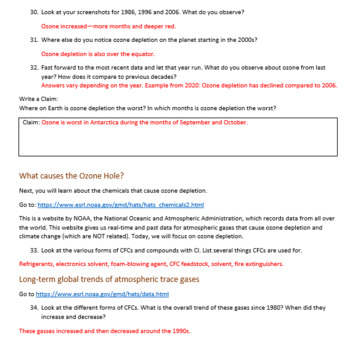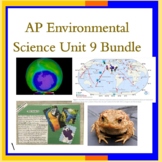Ozone Depletion Data Analysis 5E Lab-- Computer Lab
- Word Document File
- Webquests
What educators are saying
Also included in
- Use these products to help your students learn important topics and skills.Price $10.00Original Price $11.25Save $1.25
- This bundle includes these resources for AP Environmental Science including:Study guides with EXACTLY what students need to know for each unit (more detail than the CED). Full practice exam.Lots of labs and activitiesGraphic organizersMath practiceDiagram and chart notes for specific, difficult topPrice $200.00Original Price $227.25Save $27.25
Description
Use this inquiry lab with in-person or distance learning students. 7 pages for students with key included. This lab is not a simulation, but rather looking at data from various sources.
Time: 2-4 days (90 minutes to 3 hours depending on level of students and whether you choose to assign the elaborate and evaluate)
Students use real online data to determine trends in ozone depletion around the globe and trends in ozone-depleting chemicals along with the science and current trends.
Use with Environmental Science, AP Environmental Science, Chemistry or Earth Science classes.
Students need access to a computer—working in pairs suffices.
5E
Engage: Quick, simple questions about sun protection for students to use previous knowledge about the sun and UV rays.
Explore: Students use several NOAA websites to determine where ozone depletion is the worst, the months ozone depletion is the worst, and the trends over the decades and make a claim.
Next, students review information about CFCs and HFCs, analyze graphs about their usage, the Montreal Protocol and make a claim.
Explain: Non-fiction text to explain how stratospheric ozone is formed and destroyed, why Antarctica and which months.
Elaborate: (optional): A short activity with articles about ozone depletion in 2019 and 2020 and the need for long-term data in science.
Evaluate: Finding Solutions (optional): Students practice with making claims and evidence as they read a position paper about strengthening the Montreal Protocol.







